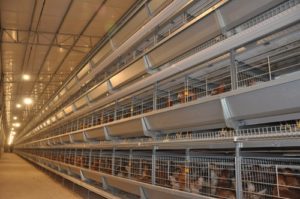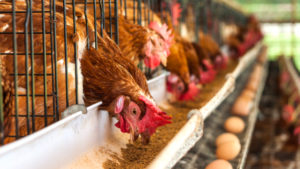Farmers all know that there is widespread waste of feed during the breeding process, but they don’t know what measures to take to prevent this from happening. The waste of chicken feed will cause the economic benefits of farmers to be lost. So Chicken Breeding Equipment Machinery will tell farmers how should farmers reduce the waste of feed and improve the feed conversion rate during the breeding process? From the straight

Introduce some specific methods to the farmers in two aspects: connecting and indirectly reducing feed waste.
Directly reduce feed waste
Place the trough at a suitable height.
If the trough is placed too high, it will affect the feeding of the chickens. If it is placed too low, it will cause the chickens to fiddle with the feed and cause waste. Therefore, the height of the feed trough should be appropriate for breeding, and the upper eaves are generally high. 2 cm from the back of the chicken.
Strengthen water tank management.
Leaking water in the sink, insufficient levelness, and the breeder scrubbing the sink, etc. will cause the water in the sink to flow into the trough, causing the feed to become moist and mildew. Therefore, it is necessary to strengthen the management of the water tank, and the chicken cage manufacturer recommends that the farmers use the nipple drinker for water supply.
Control the amount of feed.
When feeding, it wastes 15% when filling the chute at a time, adding to two-thirds of the chute depth is a waste of 12%, adding to a half of the chute depth is a waste of 5%, and adding to a third of the chute depth is a waste 2% or less. Therefore, it is necessary to strictly control the feed volume, and the feed volume at a time cannot exceed one-third of the depth of the trough.
Cut the beak of the chicken in time.
Beak cutting can not only prevent the phenomenon of pecking in the flock, but also effectively reduce the waste of feed. However, cutting the beak too early or too late cannot achieve the expected purpose, so the beak cutting should be done at an appropriate time. In general, the first time is 7-10 days old, and the second time is around 12 weeks old.
Indirectly reduce feed waste
Maintain a suitable temperature in the chicken house.
If the temperature in the chicken house is too high or too low, the metabolic rate of the chicken body will increase, which will increase the consumption of chicken feed ingredients, which will cause the waste of chicken feed. Therefore, various measures must be taken to ensure that the temperature in the chicken house is within the appropriate range. .
Use high-quality feed.
If the protein, energy and other nutrients in the chicken body are insufficient, or the ratio is unbalanced, the production capacity of the chicken will be reduced, which indirectly causes feed waste. Therefore, high-quality full- price compound feed should be used when feeding chickens, which can promote the growth and development of chickens, and increase egg production, so that the conversion rate of feed can reach the highest.
Do a good job in the prevention and deworming of chickens.
Chicken flock sickness will directly affect their growth and egg production, and indirectly cause feed waste. Therefore, a reasonable epidemic prevention plan must be customized for the flock and regular vaccination should be carried out to reduce the occurrence of flock diseases.

Ensure reasonable lighting.
Laying hens have too long light time and too much intensity in layer cage system, and feed consumption will increase; too short light time and too little intensity are not conducive to laying eggs. Therefore, it is necessary to develop a reasonable light system to ensure that the laying hens have 14-16 hours of light per day and 7.5-10 lux light intensity.
Feed the chickens grit regularly.
Chickens do not have teeth. Hard food must be ground into the stomach with the help of gastric peristalsis and grit. The feed does not contain grit. If grit is not regularly fed, the digestibility of the feed will be reduced by 3%-10 %. Therefore, it is necessary to feed the chickens with grit regularly, usually once a week, 5 grams each time.
The above is the summary of the chicken cage manufacturers to the farmers about the measures that should be taken in both indirect and direct reduction of feed waste. I hope that today’s description will help farmers to reduce feed waste in the future.